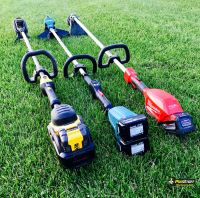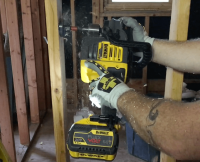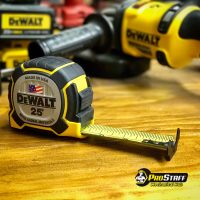Are you ready to ditch the gas can and forever say goodbye to pesky 2-stroke engines that, for no matter how hard you try, never seem to run right come springtime? The big three tool manufacturers have hit the summer of 2017 running with cordless string trimmers, blowers, hedge trimmers and even chainsaws that operate Read more
Industry Blogs

Are you ready to ditch the gas can and forever say goodbye to pesky 2-stroke engines that, for no matter how hard you try, never seem to run right come springtime?
The big three tool manufacturers have hit the summer of 2017 running with cordless string trimmers, blowers, hedge trimmers and even chainsaws that operate on the same batteries you have in the shop or on the job.
Banking on the more power is better philosophy; these cordless yard machines are delivered with large capacity battery packs. The same batteries running high demand tools like right angle drills, rotary hammers and saws.
Whether you’re tired of finicky small engines or have better things to do with your time than make that last minute run to the gas station just so you can mix up a gallon or two to trim out the yard, these tools are definitely worth looking twice at.
Here is a quick rundown of my own experience with the Dewalt 60V, Milwaukee 18V and Makita 36V OPE. Watch for additional reviews as more tools are arriving weekly here at The Hub.
Milwaukee M18 FUEL String Trimmer
New product/tool design engineers are always tasked with designing the next best thing, the fastest or most powerful tool that will turn heads and ring in sales. One guiding principle in design is the “KISS” method. Standing for “keep it simple stupid” but it’s not necessarily a negative connotation in the final production model of the M18 string trimmer.
 With a simple safety locking throttle trigger, high/low speed selection and a single 9.0Ah battery pack this trimmer is as simple as it gets. Oh yeah, and its extremely powerful. The 14”-16” cutting swath and straight shaft are perfect for clearing thick overgrowth or manicuring your 9th hole-like lawn.
With a simple safety locking throttle trigger, high/low speed selection and a single 9.0Ah battery pack this trimmer is as simple as it gets. Oh yeah, and its extremely powerful. The 14”-16” cutting swath and straight shaft are perfect for clearing thick overgrowth or manicuring your 9th hole-like lawn.
I only wish my video turned out a little better but you’ll have to take my word for it, this 18V tool is a beast when considering power and runtime. You’ll want to have a 9.0Ah battery but you’ll only need one to finish your yard. I trim about an acre and can complete the job on about 2 bars.
Dewalt 60V MAX String Trimmer If you’re familiar with the new FLEXVOLT tool lineup from Dewalt then take a look at this trimmer. Running on a single 60V 3Ah FLEXVOLT battery, this cordless trimmer has a ton of power upfront and decent battery runtime. Motor placement is different than all the others in this category in that it’s placed directly at the head/end above the line spool. Like the other two here the 60V MAX uses full-sized trimmer line, which absolutely rocks when comparing these trimmers to early models of electric/cordless trimmers. I have run this trimmer thru some pretty tough paces and have been thoroughly impressed with its power. I’m a little concerned with the amount of debris buildup on the motor housing but I believe most of that is from using it to clear heavy overgrowth in the field out back. Typical yard usage would likely not cause such buildup and therefor not pose a problem to the motor itself.
Makita 36V String Trimmer
If you’ve got a couple Makita 5Ah batteries and enjoy a tool truly designed with the user in mind then look no further.
The Makita XRU09 string trimmer has an outer rotor brushless motor direct drive system which provides for high power and high torque. The engineers included nearly all the bells with this one giving it two speeds and even reverse. You might be wondering “why reverse” and the answer is simple really. When clearing tall grass or weeds in heavy overgrowth areas the head of any trimmer will likely be wrapped up over time; the reverse rotation setting allows for quick clearing of the trimmer head and in my opinion that simple genius in design. They added a switch and circuitry to run the motor backwards for a short duration, why didn’t the others do that? I personally like the ergonomics of this trimmer best. Its also smoother and powerful enough to handle all my trimming needs over nearly and acre of yard and landscaping. Videos are still in the making.


Screwdrivers are screwdrivers, right? In as many years on the job as I’ve had I’ve personally used or seen screwdrivers used for any number of purposes beyond their original intent. I’m not proud of that but sometimes you do what you have to do. Then one day you realize the value of a nicely designed Read more
Screwdrivers are screwdrivers, right? In as many years on the job as I’ve had I’ve personally used or seen screwdrivers used for any number of purposes beyond their original intent. I’m not proud of that but sometimes you do what you have to do. Then one day you realize the value of a nicely designed tool and would in no way misuse it like the many tha came before it.
This is one of those tools. Take one a look at its compact design, fine machining and ergonomic design and its easy to see why we chose to do a review on something as simple as a screwdriver. I’ve heard others affectionately call this the “James Bond” of screwdrivers and for good reason. Take a look at the video, its only one minute long and I’ll show you all the features of this cool tool. If you’re interested in purchasing it visit our friends over at KC Tool.
https://www.youtube.com/watch?v=fYUj62ByHhw

Dewalt’s Flexvolt 60V Stud & Joist Drill may look familiar, I mean without the battery and add a cord, paint it red and you might be reminded of an old industry mainstay. But let’s forget about that old drill, made by another manufacturer and focus on what I might call the most powerful cordless tool Read more
Dewalt’s Flexvolt 60V Stud & Joist Drill may look familiar, I mean without the battery and add a cord, paint it red and you might be reminded of an old industry mainstay. But let’s forget about that old drill, made by another manufacturer and focus on what I might call the most powerful cordless tool I have ever used.
The two variable speed settings (forward, with single speed reverse) coupled with the ” E-Clutch® System” make for a high performance machine ready to handle probably anything you throw at it. I must remain honest and admit that I entered this review thinking I already knew how it would perform but not only that but how I would be sure to point out a huge flaw in the overall design. After using the drill on multiple projects, large and small, I can not say I have found a definitive job task this drill should be able to perform but cannot. Because it can and will, and it will do it faster and safer than any other drill before.
The E-Clutch system senses reactionary torque caused by a bind-up or stall and reduces speed to a manageable level until control is regained. This is a significant technology and the first in any large pattern, full-sized rough-in drill I have used. All right-angle drills I have used, owned or tested have had mechanical clutches. Mechanical clutches are sufficient only that they will save your knuckles, face or knuckles and face sometimes but the problem is they will not always prevent a hard stop or throw from a ladder. In fact most of the time when a mechanical clutch engages on large right angle drills the user is thrown or pinned up against a nearby object and almost always materials are damaged. The E-Clutch is sensitive but will allow you to get the job done without excessive engagement and stopping. Its so smooth it will take a few engagements before you’re completely aware of why the drill stopped and what exactly is going on, I know I felt this way at first and drilling with a right angle drill is nothing new for me this long into my plumbing career.
For the video review I loaded the drill with a 3.0Ah Flexvolt (9Ah 20V equivalent) battery,fully charged. The battery had been used multiple times before on other Flexvolt and 20V MAX tools. After drilling every hole needed to complete the drain, waste and venting rough-in on a three bath house, 40 holes 2-9/16″ & 3-5/8″ diameter, the battery had used 1/3 of the total capacity as indicated by illuminating 2 of the three LED lights on the battery when finished. The whole house was drilled using nothing but cordless and not more than one battery. What a time to be alive.
The weight of the drill and its balance seem comfortable although the d-handle protruding off the backside of the head is less useful for actually drilling than it is useful for carrying and pulling the drill and bit from a completed hole. I have not used the side handle bar for any holes to date but it is included in the kit and would be useful for added control while drilling or mixing various materials like small batches of concrete or drywall compound etc.
Overall I was thoroughly impressed, I could not find any detail that stood out as a flaw or that I would consider suggesting to change. It provides more than enough power needed to complete a plumbing, hvac or electrical rough-in with ease. Its fast and efficient in its use of battery power; evident by the battery capacity used to drill all the needed holes in the video. As the Flexvolt system continues to grow and remains backwards compatible with all the 20V MAX tools I can without a doubt recommend taking a close look at this tool if you’re thinking of trying a new tool line or already on the 20V MAX platform and need to add a high performance right angle drill to your tool arsenal.


Cordless outdoor power equipment [OPE] is not entirely new but the application of today’s battery technology coupled with the performance of highly efficient and powerful brushless motors has created a whole new level of tools for both residential and commercial use. Although Dewalt’s DCCS670X1 FLEXVOLT 60V MAX brushless chainsaw is considered the homeowner’s Read more
Cordless outdoor power equipment [OPE] is not entirely new but the application of today’s battery technology coupled with the performance of highly efficient and powerful brushless motors has created a whole new level of tools for both residential and commercial use.
Although Dewalt’s DCCS670X1 FLEXVOLT 60V MAX brushless chainsaw is considered the homeowner’s tool, separate from the 40V MAX commercial lineup, this chainsaw further expands the usefulness and value of investing into the FLEXVOLT tool platform. Arguably more agile than the 40V MAX chainsaw given the more compact battery pack [60V, 3Ah] it weighs in a full pound lighter [12.2lbs]. As one of three 60V MAX OPE tools this model is equipped with a low kickback 16” Oregon brand bar. Chain break, auto oiling and tool-free chain tensioning round out the saw’s main features.
Ratings from the Dewalt engineering team have it set at approximately 70 cuts per charge on 6”x6” pressure treated pine. Our tests shown in the video included various diameter log and stump cutting ranging from 5” to 14” oak. Our time in the woods allowed for 100 cuts, requiring one battery change at cut number 64. In total the saw consumed 1 & 2/3 batteries.
This isn’t plumbing related…
A few of our friends on social media have asked why we’ve been showing the cordless OPE so much this spring, noting it isn’t plumbing or hvac related. While I’d totally agree these tools are a bit off our scope of product and trade focus I’d offer up the fact that most people have a use for these tools at home AND on the job site. The blowers for example are a huge time saver over a push broom, the chainsaws could prove useful as well but overall I find them truly exciting because of how well thought out and powerful they are. Given I already have invested heavily into cordless tools for my business, expanding the utility of my own batteries into helping me get some work done around the yard is attractive. Besides, who wants to deal with the incessantly fickle 2-stroke motor with its annual carburetor issues? With these battery tools you just insert a battery off the truck, pull the trigger and go. Very cool indeed plus tools like the chainsaw ans trimmer are extremely quiet allowing for that one last pass thru trimming up the yard at 9:30pm, likely without your neighbors even knowing it!
Back to it
The saw performed flawlessly in everything we threw at it. Honestly I was impressed over and over at the power available as I pushed the saw searching for it’s limitations. The oak hardwood was fell earlier this spring but only cleared to make way for a future building site, no rot was present which made these tree trunks prime for challenging the saw.
So you may be wondering if the newest generation of battery operated outdoor power equipment is worthy for the pro jobsite and to that I’d have to honest and say these tools will not completely replace a gas engine model in all instances but as you can see in the video Dewalt’s chainsaw has packs some power and provides a considerable runtime overall. I own other Flexvolt batteries and will consider this my new chainsaw of choice because of the power and agility it offers. Add to that the fact that this electric motor comes complete without a 2-stroke carburetor and the hassle of annual starting issues. As the battery OPE offering continues to expand by all major tool brands we are looking forward to testing out additional tools as they come to market so please watch for those reviews soon.
Dewalt’s OPE warranty as stated on their website is as follows: 3yr Limited, 1yr Free Service, 90day Money Back Guarantee.
Local retail pricing (Minnesota): $329.00
Available online and in stores now. Check out @acmetools or Home Depot for this and other FLEXVOLT tools by Dewalt.
Not paid content. This review is one of many performed by the mechanical-hub.com ProStaff, a team of skilled trade professionals who love tools and sharing info with our industry friends. A special thank you to Heather Aune, my lovely wife for helping with not only the camera work for this review but also testing out the saw herself, a significant task given she’s never even touched a chainsaw in her life before this test!

The DEWALT XP™ Tape Measure (DWHT36225) is re-engineered from the inside out. The result is a compact, professional-duty ergonomic tape with a case designed for a better fit in the user’s hand. I got my hands on the new XP tape this week, a couple months before it will be available for sale and I Read more
The DEWALT XP™ Tape Measure (DWHT36225) is re-engineered from the inside out. The result is a compact, professional-duty ergonomic tape with a case designed for a better fit in the user’s hand.
I got my hands on the new XP tape this week, a couple months before it will be available for sale and I have to say Dewalt may have hit it out of the park with this one. Here are some highlights:
- Impact-resistant PC/ABS and rubber case is engineered to survive drops up to 60 feet.
- 9″ of heavy-duty thermoplastic coating at the beginning of the blade to provide 3X more blade protection, reduces blade breakage near the hook.
- Three-rivet fastened, extra large end hook grabs construction material from all four sides making grabbing objects while taking measurements easy.
- “Dual-Core Technology” internal return spring [dual springs that are more compact and powerful]
- Availability: Canada- May, US- July 2017
- Retail price: $29.95 US
I have a thing for tough, well made tape measures. There are a lot of poorly made, poorly engineered tapes out there but the new XP has zero traits in common with any of those tape measures in my opinion. From the moment I picked it up and felt the heft in my hand to the last time I threw it in my tool bag for the day I could feel the quality and engineering built into the XP.

The large hook end is designed to grab from all four sides, this type of design has long been an area of contention for many. Some people prefer a smaller hook to fit inside pipe or smaller openings, others like that a large hook will grab the end of material easily with the blade extended. I understand both arguments but in the end I guess I prefer the convenience of the large end and being able to easily hook the end of a pipe quickly. For insertion measurement I’ll just stick to grabbing my folding ruler, I feel more comfortable with that in the situation.
Inside the rugged exterior are two internal recoil springs. Dewalt is calling the new compact return spring system “Dual Core Technology”. The more compact design allows for a more powerful return of the tape from longer extensions but allows for a smaller design overall compared to other tapes already in the marketplace. The snap back as the tape returns for 10′ extension is enough to jolt your hand a little, the power is noticeable.

This closeup shows the end of the thermoplastic coating applied to the top of the blade. The coating is engineered and place there to extend the life of the highest wear-point of the blade. Its hardly noticeable except for the slight gloss added. Time will reveal whether this coating will mar with use but no visible distortion is present otherwise.

Overall I really do like the feel of the tape in my hand. The rubber and plastic exterior had just the right amount of grip in my bare or gloved hand. The steel belt clip seems more than adequate, though it is the straight metal design that tends to tear clothing if used regularly.
As a Stanley Black & Decker brand, DEWALT has created a rival to the longtime industry champion Stanley FATMAX tape with the new XP. If I’m honest I admit that the MADE IN THE USA labeling excites me. Dewalt could easily have manufactured this overseas, no matter where the materials were sourced, but they aren’t and ultimately that means jobs for our neighbors. Nice work, Dewalt.


